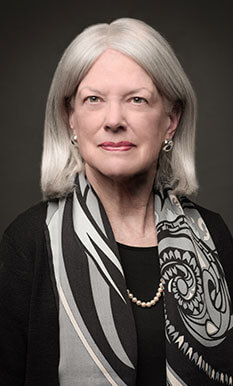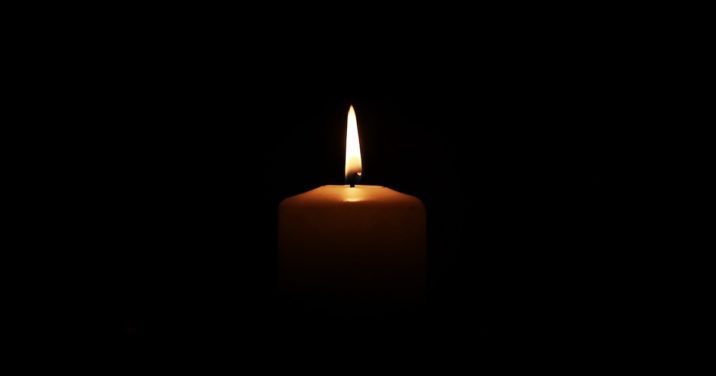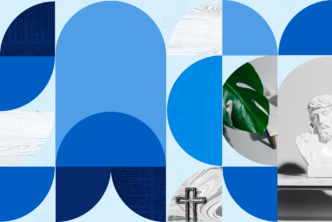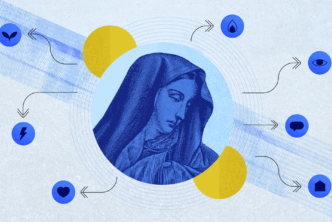“Advent is for the few.” That’s one of the first things Rev. Fleming Rutledge said to me in our recent interview about the Advent season.
This time of year, it’s easy to let our imaginations return to the sights, sounds, and smells of past Christmases, to gladly jump into the hustle and bustle of the season, and to return to the stories and songs we’ve loved (like Elf and “Hark! The Herald Angels Sing”—two of my favorites). It’s also easy to get caught up in the sentiment behind phrases like “Jesus is the reason for the season” and nativity plays—which are great, but they aren’t at the heart of the historical Advent.

Rutledge, author of Advent and The Crucifixion (among other books), gave me a glimpse into the drama of Advent that we are invited into. Listening to her speak about the darkness and light of Advent brings to mind a quote from Dorothy L. Sayers: “The Christian faith is the most exciting drama that ever staggered the imagination of man—and the dogma is the drama.”1
The drama of Advent follows another storyline, one that not everyone is willing (or even capable) to embed themselves in for the four weeks preceding Christmas. It’s a story of darkness and light in which a King who seems far away is actually nearer than we might have believed (Rom 13:11), and he’s returning to enact justice and restore the broken. Advent takes us back to the parables and prophecies, replacing seasonal saccharinity with a truer, deeper joy that can withstand suffering, sin, and strife.
That’s the story Rutledge told in our (too brief) conversation. And it’s the story I invite you to hear in this article based on my interview with Rev. Rutledge.
Advent begins in the dark
When Rutledge writes, “Advent begins in the dark,”2 she’s talking about suffering, sin, and the apparent hiddenness of God (that is, we often cannot sense him). She’s talking about the Christians in Ukraine who worship without electricity or running water, the school-aged children whose lives were changed during the pandemic, Christians and non-Christians alike who wrestle with doubts and fears. Advent begins in the dark because we live in the dark.
But the darkness of Advent can be too heavy to bear—one reason that Advent is for the few. “It is not the fault of many people that they just can’t tolerate very much suffering or darkness. They have the luxury of tolerating it or not tolerating it,” she says. “If they were under Russian bombardment, they would have no option. But in our society, it is possible to live in denial. And many people have been raised to live in denial. They have been raised to believe that it is best always to look on the bright side of everything.”
What Advent teaches us, she says, is to recognize hardship. “I went to a seminar about suicide,” she recalls. “And I was arrested by what one of the experts said several times: steer toward the pain. … I have thought about it many, many, many times since, not just in relation to suicide, and I have quoted it often with the hope that somebody will pick it up for their own life as I did. … You’re supposed to steer toward the pain. And of course that is what Jesus did more than anyone else who’s ever lived. And he did it every day of his life. His death was the ultimate example of steering toward the pain, taking it on himself to the last drop of agony, public suffering. So it doesn’t matter thinking about it, but we have to think about it. And I think it’s a good motto for Advent. Steer toward the pain.” Put another way, we don’t have to put on a happy face or hide from our troubles. “Steering toward the pain” can simply mean acknowledging it in the light of Jesus Christ, who knows suffering and comforts us no matter the challenges we face (Rom 8:17; 2 Cor 1:4–5).
The light still shines in the darkness
As uncomfortable as it is, especially this time of year, to steer toward the pain and darkness, Advent reminds us that the darkness makes the light even starker. “Advent has traditionally been a season of darkness in which the single light of Christ is a beacon,” she says. “One candle in the dark, that is the message. And then the candle that shines in the dark, the single candle is the light of Christ.”
This metaphor of light, used memorably throughout the New Testament, was also employed by Jesus in the parable of the ten bridesmaids (Matt 25:1–13), one of the central texts of Advent. William Blake captured the parable’s essence in a painting (which also happens to be on the cover of Rutledge’s book):
In the painting, as in the parable, the five foolish bridesmaids who were unprepared for the bridegroom’s arrival plead for oil from the lamps of the prepared, wise bridesmaids. The painting helps us visualize that “over their heads, the heads of the wise and the heads of the foolish alike, over their heads, the second coming is happening,” Rutledge notes. “This startling presence of an angel above the scene is announcing the arrival of the city of God coming down from heaven. And even as I’m talking, I feel the pressure and the expectation and the astonishment of what Jesus is talking about, that there will come a day in the future unknown, not able to be predicted by us, but the day is coming when he will return in majesty, in glory and he will bring with him the new city of God down from heaven to earth.”
With this painting, she continues, Blake has “brought the kingdom of God down to earth where the book of Revelation says it’s going to be. Not up in the sky but down on earth. The new creation of this very present creation, healed of all its sin, sorrow, death, injustice, misery, inequity, hatred, war, calamity, plague, pestilence and famine, battle, murder and sudden death—all of it will be wiped away and obliterated in the brilliance of the coming of the son of God.”
Are we ready?
This, then, is the promise of Advent: the world is not as it should be, and Jesus Christ is coming again to set all things right. We don’t know when the bridegroom will return, but we know he will. “The bridegroom’s arrival at midnight is expected, and yet we’re not ready,” Rutledge says. “We haven’t got any oil in our lamps. We burned it out. We lit all the lights too soon. We didn’t wait.”
“Wake, awake, for night is flying,”
—Philipp Nicolai, “Wake, Awake, for Night Is Flying“
the watchmen on the heights are crying;
“awake, Jerusalem, arise!”
Midnight hears the welcome voices,
and at the thrilling cry rejoices:
“Oh, where are all you virgins wise?
The Bridegroom comes, awake!
Your lamps with gladness take! Alleluia!
With bridal care yourselves prepare
to meet the Bridegroom, who is near.”
The purpose of Advent, then, is to prepare us: “The readiness of the church is enacted in the Sundays of Advent and the three Sundays preceding Advent, the lessons and the hymns when the season is done fully, the lessons and the hymns of those seven Sundays are just resonant, replete with that atmosphere.”
And as we pay attention to God’s promise of a “new creation and a second coming,” we are also listening for the voice of the watchman who tells us that the bridegroom is on the way. As we wait and listen for Jesus’ second advent, we act in ways that reflect our hope in the promise.
“Works of mercy are necessary in order to ratify our commitment to this promise,” Rutledge adds. “I’d like to emphasize works of mercy in reaching out in monetary and concrete ways to alleviate suffering, to think about those for whom Christ had special concern and made it so clear in his life among us.”
The last week of Advent
The last week of Advent may be the most challenging week to stick to as the bustle of the Christmas season often breaks in through Christmas Eve services and last-minute shopping and family gatherings. Yet, as Rutledge says, it’s worth it.
“The music and the readings just get more wonderful as you get into the last week of Advent, the prophecies from Isaiah, the words of some of the hymns and songs,” she says. “People, Look East,” a carol by Eleanor Farjeon, is particularly poignant for Rutledge. One stanza of the carol “talks about the barren nest, the barren frozen nest in the middle of the winter and how there’s no life in the nest. And as a bird lover, that image penetrated me this Advent season as never before. The last line of that verse is, ‘Love, the bird, is on the way.’ That idea of love, for which we mean Jesus, is on the way. … That should be the message of the last week in spite of plague, pestilence and battle, murder and sudden death. There was a promise.”
That promise brings the message of Advent home: “The bridegroom is coming,” she says. “It’s midnight, but he’s coming. And we can be ready. We can be ready by the smallest things. A heartfelt prayer, a check written, a visit made, a kind word spoken. Those are ways of lighting candles in the dark. But those candles would not mean very much in the ultimate sense were it not for the knowledge that Jesus is the light and his promises cannot fail. … He is on the way.”
Amen, Maranatha.
***
Want to learn more about Advent? I recommend starting with this article and Fleming Rutledge’s book, Advent: The Once and Future Coming of Jesus Christ. Rev. Rutledge would probably want me to tell you that if you’re going to observe Advent, you can’t do it partially. It just doesn’t work the same when your imagination is split between Advent and Christmas. If you missed Advent this year, you can start preparing now for next year.
Traditionally, Advent is observed through corporate and personal readings of the Bible (such as are found in the Book of Common Prayer or Revised Common Lectionary) and delaying the Christmas season (with all the decoration and carols) until Christmas Day. Each Sunday has a specific theme, and one candle is lit each Sunday until all four are burning. The Twelve Days of Christmas, so memorialized in the song about entirely too many birds, come after the season of Advent and go from December 25 through January 6, also called the Epiphany. This is when all the fun parts of Christmas are unleashed in a torrent meant to sweep us all up in the joy of the Incarnation.
Choosing to delay Christmas so you can focus on Advent requires an awful lot of restraint. But it’s worth it.
Resources to learn more about Advent
- Dorothy L. Sayers, “The Greatest Drama Ever Staged” in Creed or Chaos? And Other Essays in Popular Theology (London: Methuen & Co, 1947), 1.
- Fleming Rutledge, Advent: The Once and Future Coming of Jesus Christ (Grand Rapids, MI: William B. Eerdmans Publishing Company, 2018), 251.






